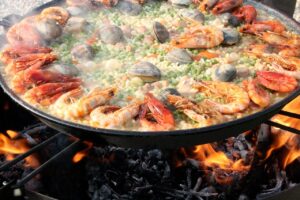As everyone’s most favorite comfort food, pasta has a long history of culinary greatness in different parts of the world. The origin of pasta has always been speculated between Italy and China, but nearly every country has its own unique version of pasta. With a few common ingredients of flour, water and eggs as the basic recipe, let’s dig in to learn more about everything pasta below! We will start with the differences between dry and fresh pasta.
Here are the differences between dry and fresh pasta!
Do you know that pasta is commonly categorized by ‘dry’ and ‘fresh’? Here is each pasta type explained :
- Made with flour, water and salt.
- Can be stored at room temperature almost indefinitely.
- Has many varieties, especially those from Italy, have an authentic flavor and consistency.
- Its texture is quite firm and works well with heavy sauce.
- Most shapes double in size when cooked.
- Made with flour and eggs, plus additional water.
- Has shorter shelf life compared to dry pasta.
- Often locally made and kept in refrigerated section in supermarket
- More tender and takes shorter time to cook.
- Delicate texture, making it best with light sauce such as tomato, cream, oil or butter.
As you read through their characteristics, you will realize that no pasta is better than the other. It is because they are both superior type of pasta which all comes down to your personal taste and preference.
Shapes and Varieties
Pasta lovers must all have known some of the most common pasta types based on different shapes and sizes. They are available everywhere and often represent the normal definition of pasta, such as spaghetti, fusilli and fettucini.
At LuxoFood, we carry different types of pasta based on different shapes, varieties and brands. We also would like to shed some insight on our handmade fresh pasta by Italian chefs below :

Gnocchi are tiny, soft dumplings traditionally made from potato, egg, and flour. With a size of a small cork, it often features potatoes, spinach, ricotta, eggs or cheese. This hearty pasta is perfect for rich sauces, and even stands up to baking.

One of the more popular type of pasta, it comes in long, flat and ribbon-like strips. Commonly served with bolognese sauce, it is almost similar with fettuccine but usually tagliatelle is thinner. You may substitute one for the other too.

Also almost to spaghetti, except thicker, tagliolini is a long, ribbon-like pasta that measures at about 0.5cm. The strands are sometimes cylindrical, rather than flat in appearance. It works great with various sauce, but mostly paired with bolognese.

Shaped like small square pillows, ravioli is another favorite that can pretty much be cooked with anything. You can fill it with cheese, meat, veggies, or even seafood. With unique ruffed edges, this pasta is a wholesome pasta experience you simply have to try.
How to Boil Pasta
Boiling pasta seems simple enough, but this supposedly simple thing can prove to be the trickiest.
So let us simplify this once and for all with steps below :
 Use a large pot with enough room for the pasta to move around. Avoid crowding the pasta into a tight ball once they’re all boiled.
Use a large pot with enough room for the pasta to move around. Avoid crowding the pasta into a tight ball once they’re all boiled.
Use lots of water. Adequate amount of water is necessary to create the perfectly boiled pasta so that they don’t stick to the pan.
Salt the water. Starchy food tends to taste better with generous salt, so stir in about a tablespoon of salt at least.
Bring the water to a full boil, before dropping the pasta in.
Stir, and keep stirring till your pasta hits its “ ready” timing ( as per cooking instruction) or your preferred consistency.
It is also recommended to save a scoop of pasta water to mix with your sauce. This ‘leftover’ water is great for binding the sauce and pasta together, creating a balance of yummy taste.
Sauce It Up!
In need of some delicious quality sauce to go with either your fresh or dry pasta? Don’t forget to check out Luxofood’s collection of sauces to bring your pasta experience to the next level. Follow this the general rule to using sauce with your pasta :
- Creamy or Dairy Based Sauces —> Fresh Pasta
Fresh pasta blends well with creamy or dairy based sauces because its texture can hold it better with a lighter way to baance the creaminess.
- Hearty or Oil Based Sauces —> Dry Pasta
Dry pasta has a rather toothsome consistency or firm texture that stands well with meaty and oily sauce, even spicy sauce.
- Bolognese —> Fresh Pasta
An exception to the rule, bolognese sauce works better with fresh pasta despite the fact that bolognese is a meaty oil sauce. Usually holds a thick and rich consistency, it would be too heavy to use dry pasta with your bolognese so opt for fresh pasta instead.
Still need more help in buying pasta or looking for the best sauces? Chat with us today at +62813-1552-5400 (Whatsapp/SMS) and let LuxoFood personally guide you to the best pasta and sauce experience combined.



